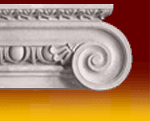|
|
The first step in making a helix is to make a pattern that defines the pitch of the helix. The pattern will be offset
from the blade so that it can be re-used and not get all cut up. Cut a piece of paper a little longer than the helix
form you want to make, and wide enough to wrap one full turn around the dowel and overlap onto itself. Wrap the paper
around tight and draw a pair of marks across the overlap. These two marks will become four shorter marks when the paper
is unrolled.
|
|
|
Draw a line between the ends of the two marks that are along the overlap. This line will be right along the edge of
the paper where it overlapped onto itself. Draw equally spaced marks along the line using one of the original marks
as a starting point. The spacing between the marks determines the pitch. In this example I used one inch spacing
for a one inch pitch. Draw a matching row of marks along the edge in the same positions along the length as the first
set of marks. Finally draw diagonal lines using the marks as endpoints. Note that the direction of the diagonals
will determine whether the helix will be left or right-handed.
|
|
|
Wrap the pattern back around the dowel. The ends of the diagonal lines will meet end-to-end to form one continuous helical
line wrapping around the cylinder. Use tape to keep the pattern from unrolling and it should be able to slide along
the dowel so that it can be aligned with the mark drawn on the V-block fence in starting position.
|
|
|
Here the end of the pattern is aligned with the mark on the V-block fence. The end of the dowel is just touching
the spiral blade (I am using a #2 Olson spiral blade here). Before you start cutting, use a spring clamp on the table
to put pressure on top of the dowel to help hold it down in the V-groove. You will probably need a small block of wood
on the underside of the table for the lower part of the spring clamp to hold on to. Make sure the top part of the clamp
is farther up on the hold-down so that it provides enough pressure against the dowel. The hold-down can be seen a few
pictures below. Tape the pattern down on the dowel after alignment to prevent slipping.
|
|
|
Ready to start sawing.
|
|
|
Twist the dowel into the spiral blade with a smooth and steady motion. Set the tension of the blade as high as
you can without breaking the blade. If you turn the dowel in a stop and go fashion it will produce lines, dips and bumps
in the surface. I have bought a few small gearhead motors from an electronic surplus store that I let do the turning
part for me so all I have to concentrate on is pushing the end of the dowel to keep the pattern aligned with the mark on the
fence. The motor is connected to a variable voltage power supply to turn the dowel at the proper speed in the neighborhood
of 2 or 3 rpm. Notice the hold-down on top of the dowel behind the blade in this picture.
|

